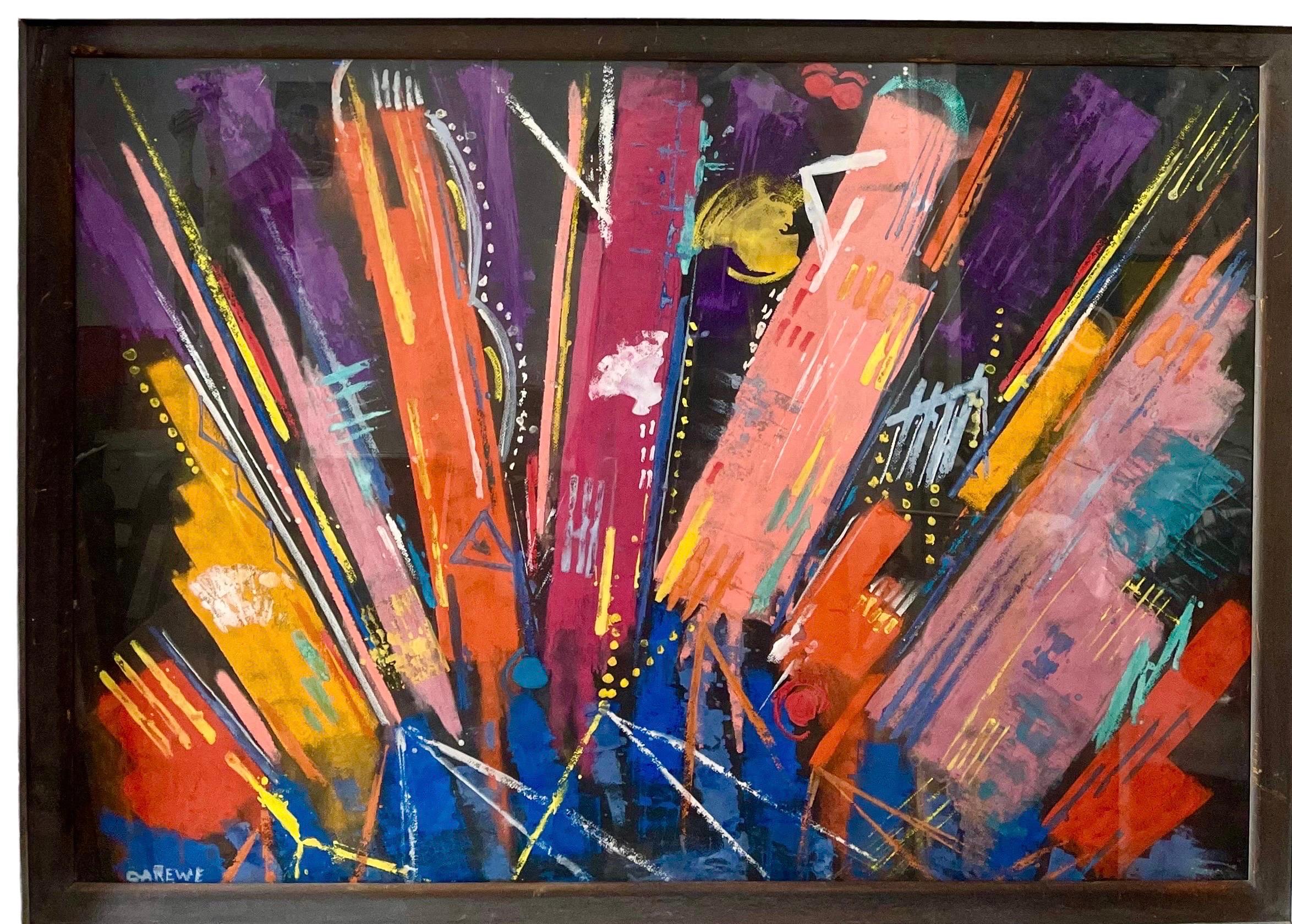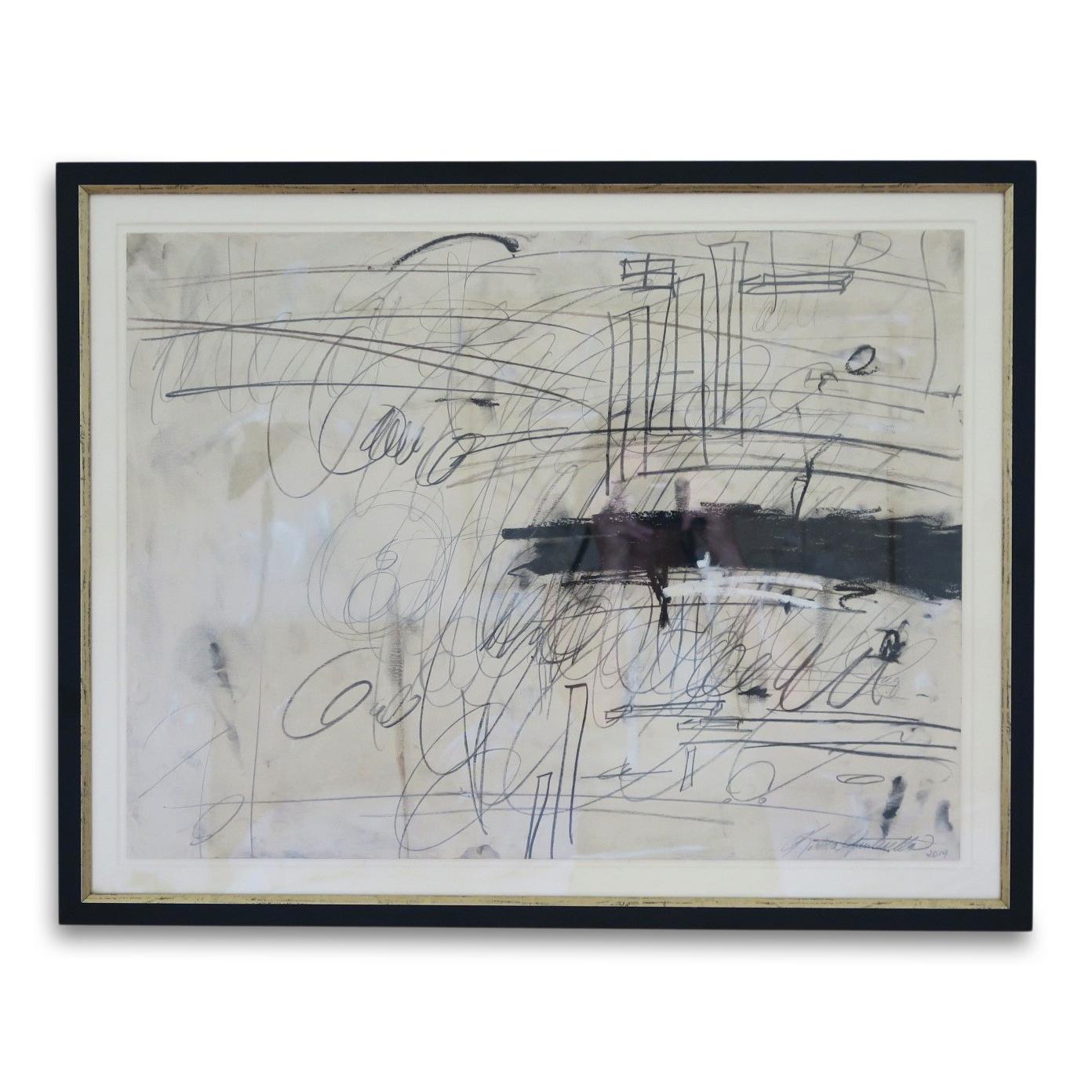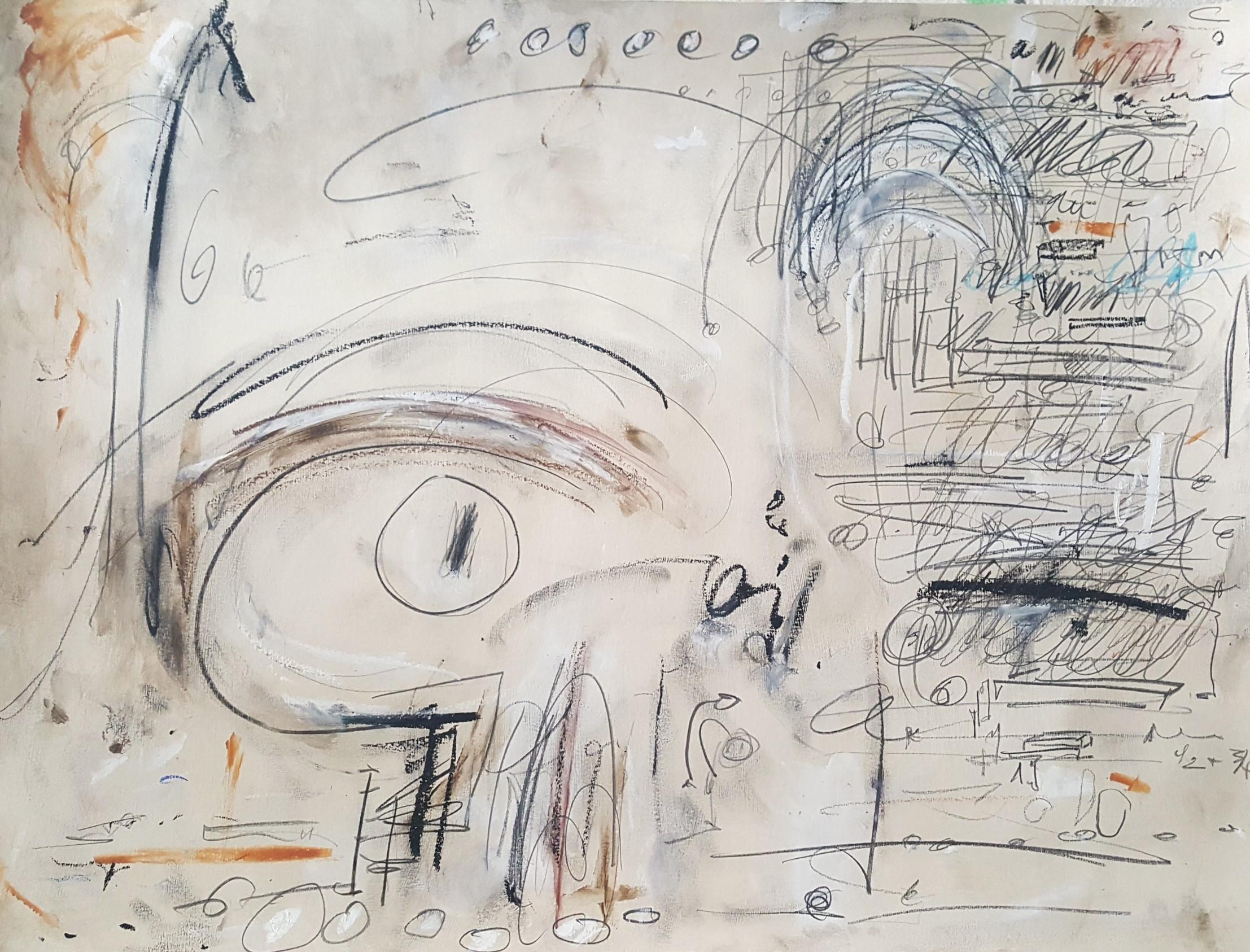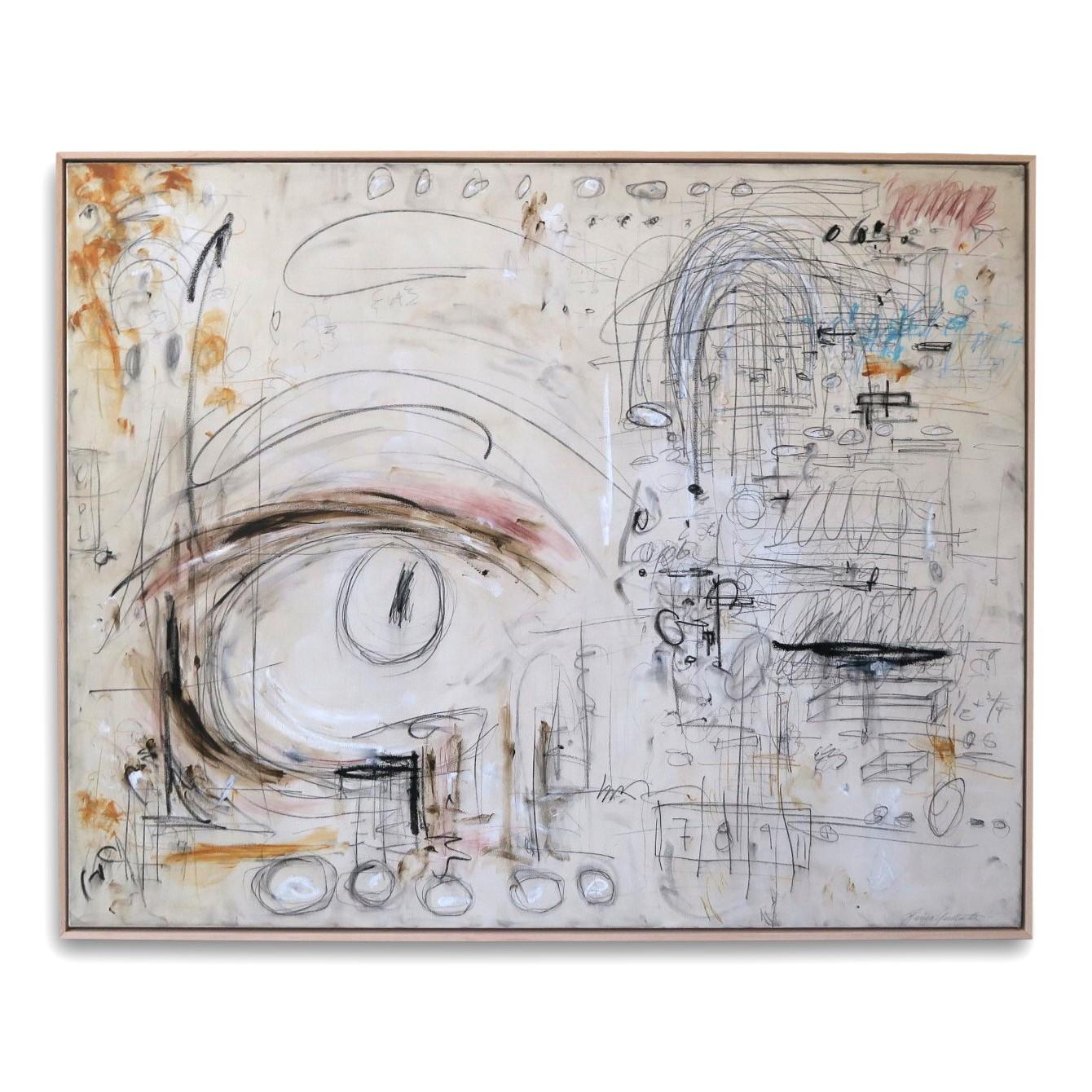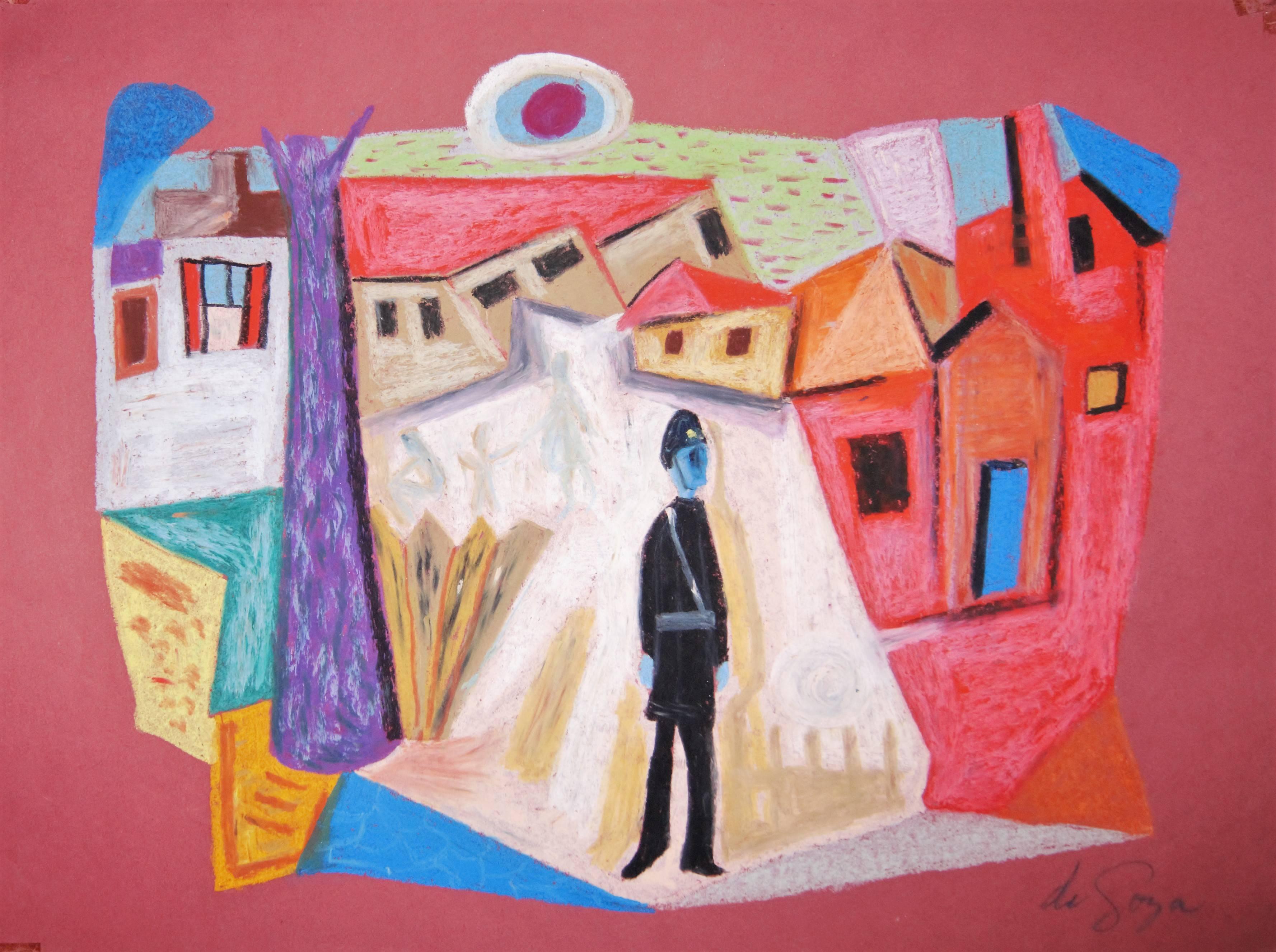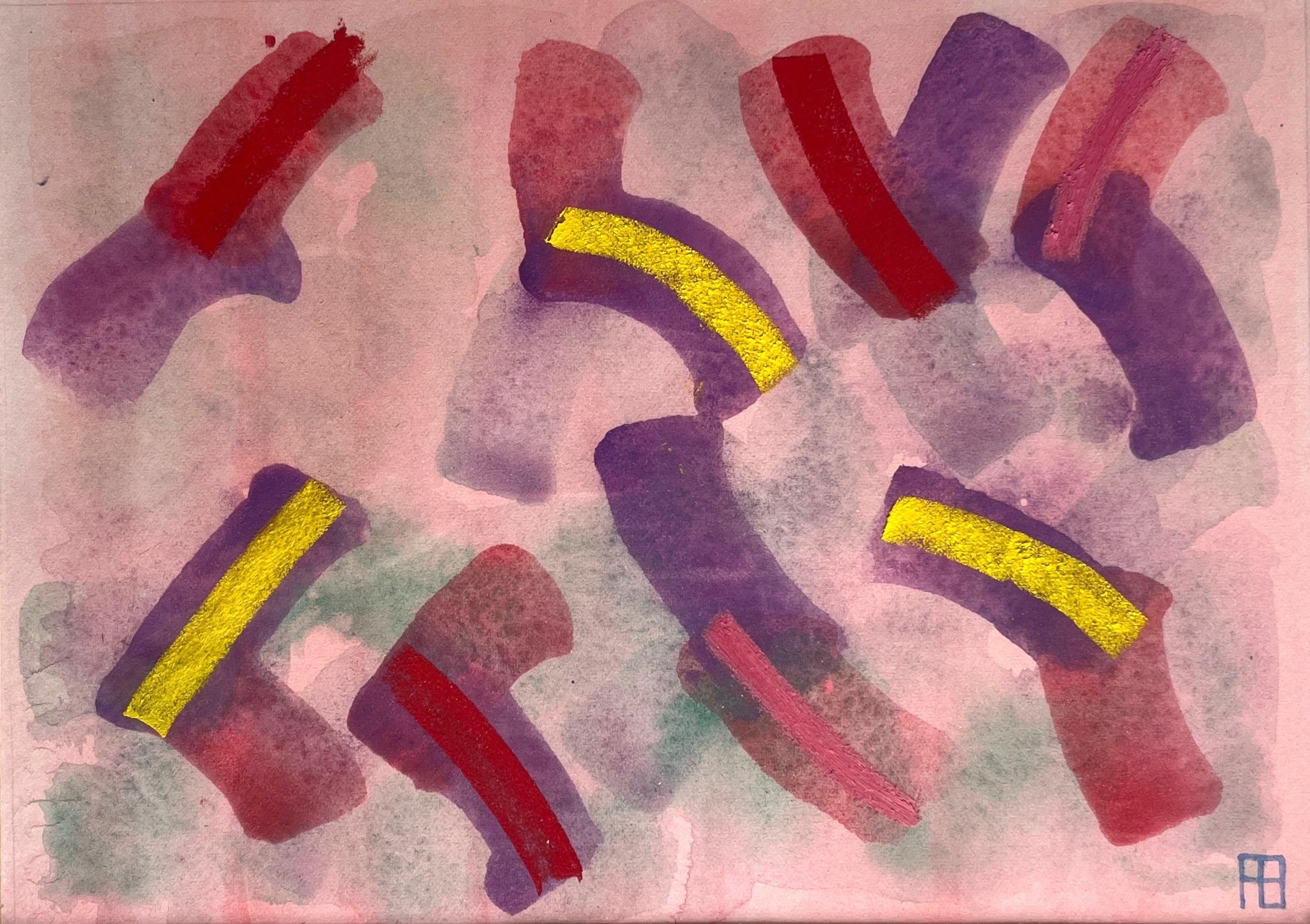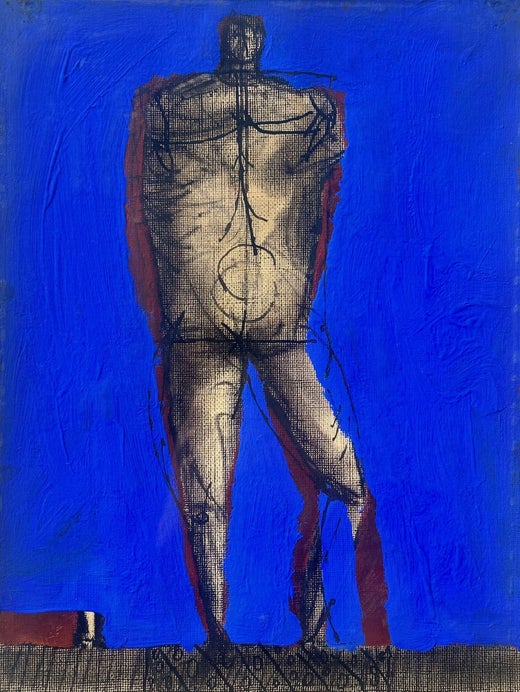Joseph GlascoFire Island, Blue & Green abstract painting by New York artist Joseph Glasco1967
1967
About the Item
- Creator:Joseph Glasco (1925 - 1996, American)
- Creation Year:1967
- Dimensions:Height: 23 in (58.42 cm)Width: 28 in (71.12 cm)
- Medium:
- Movement & Style:
- Period:
- Condition:
- Gallery Location:Beachwood, OH
- Reference Number:1stDibs: LU1768210584822
Joseph Glasco
Joseph Glasco was an American abstract expressionist painter and sculptor. Perhaps one of the best kept secrets and one of the most amazing stories of 20th century art. Glasco was born in Oklahoma in 1925. He rose to fame at the young age of 25 and was given a one man show at one of New York’s leading galleries. He was also the youngest artist to be represented in the permanent collection of the Museum of Modern Art. He was also the 15th artist selected by MOMA to tour in the prestigious “Fifteen Americans” sponsored by MOMA in 1952, along with Pollock, Rothko and others. New York was not his comfort zone. He rebelled against the curators, critics and galleries. He left New York for Taos and ultimately settled in Galveston,TX. Close friends, collectors and sponsors included Stanley Seeger and Julian Schnabel. In 1980, Glasco toured India, Turkey and other countries in the region collecting silks, cloths which he incorporated into a few of his paintings as pictured here. A truly remarkable artist and story as chronicled by Michael Raeburn in The Fifteenth American. He graduated from the University of Texas at Austin. Shortly after, he enlisted in the United States Army during World War II and he served in the Battle of the Bulge. After the war, he enrolled at the Portsmouth Art School in Bristol, England. He also studied at the School of Painting and Sculpture, in San Miguel de Allende, Mexico. He subsequently attended the Art Students League of New York. His works are on permanent display in numerous museums, including The Metropolitan Museum of Art, The Museum of Modern Art, the Solomon R. Guggenheim Museum, the Whitney Museum of American Art in New York City, the Hirshhorn Museum in Washington and The Museum of Fine Arts, Houston.
- ShippingRetrieving quote...Ships From: Beachwood, OH
- Return PolicyA return for this item may be initiated within 14 days of delivery.
- "People" - Mid-Century Ovoid Geometrical Abstract Black & White DrawingBy Clarence Holbrook CarterLocated in Beachwood, OHClarence Holbrook Carter (American, 1904-2000) People, 1964 Ink and crayon on paper Signed and dated upper right 36.5 x 24 inches Clarence Holbrook Carter achieved a level of nation...Category
1960s American Modern Abstract Drawings and Watercolors
MaterialsCrayon, Ink
- Seated Figure, 20th century figural abstract expressionist ink drawingBy Joseph GlascoLocated in Beachwood, OHJoseph Glasco (American, 1925-1996) Seated Figure 1970 India ink on paper 16 x 11.5 inches Signed and dated lower right Joseph Glasco was born in Paul’s Valley, Oklahoma and grew up...Category
1970s Abstract Expressionist Figurative Drawings and Watercolors
MaterialsIndia Ink
- The Blue Earth II, CoBrA movement, Mid-20th Century Danish WatercolorBy Carl-Henning PedersenLocated in Beachwood, OHCarl-Henning Pedersen (Denmark, 1913 - 2007) The Blue Earth II, 1971 Watercolor on paper Signed and dated lower right, signed, dated and titled verso 30.5 x 21.5 inches Carl-Hennin...Category
1970s Abstract Expressionist Figurative Drawings and Watercolors
MaterialsWatercolor
- Abstract expressionist blue, black & green mid-century geometric paintingBy Richard AndresLocated in Beachwood, OHRichard Andres (American, 1927-2013) Untitled, c. 1949 oil on canvas 18 x 32 inches Richard Andres was born in Buffalo, New York in 1927. A graduate of the Cleveland Institute of Art in 1950, he was immediately drafted and served for two years in the army as a mural painter. He received his Master of Arts from Kent State in 1961. A frequent exhibitor at galleries and museums and winner of multiple May Show prizes, Andres taught art in the Cleveland Public Schools for 28 years, as well as teaching the University of Buffalo, the Cleveland Institute of Art and the Western Reserve University. Very little in Richard Andres’ childhood would have predicted his love of classical music, mid-century-modern architecture and certainly not his lifelong passion for art and in particular abstract art. Richard’s father, Raymond, had no more than a third-grade education, and his mother, Clara, was one of thirteen children – only three of whom lived into adulthood and none of whom attended high school. They lived, when Richard was a boy, in a dingy area of Buffalo, NY in a walk-up apartment situated above a tavern. Raymond and Clara supplemented the income from their factory jobs in the bar downstairs with Raymond playing ragtime on the piano and Clara serving drinks. This often left Richard and his two older brothers at home alone to fend for themselves. The two older boys, Raymond and Russell, were - unlike Richard- rather rough and tumble and entertained themselves with stickball, boxing and the like. Richard, on the other hand, from a very young age liked to draw, or better yet even, to paint with the small set of watercolors he received for Christmas one year. Paper, however, at the height of the depression, was hard to come by. Luckily, Clara used paper doilies as decoration for the apartment and Richard would contentedly paint and then cut up doilies, gluing the pieces together to create collages. At eight-years-old, he discovered the Albright-Knox Museum (then known as the Albright Art Gallery) and spent several hours a week there studying the paintings. He was particularly fond of Charles Burchfield‘s landscapes, enamored with their ‘messiness’ and thinking that they somehow captured more ‘feeling’ than works he was previously familiar with. For his tenth Christmas, he asked for and received a ‘how-to’ paint book by Elliot O’Hare. Through this self-teaching, he assembled the portfolio needed for acceptance to Buffalo Technical High School where he studied Advertising Arts. In his Junior year, he was encouraged to enter a watercolor painting, “Two Barns,” in the national 1944-45 Ingersoll Art Award Contest and was one of twelve grand prize winners – each one winning one hundred dollars. More importantly the painting was exhibited at the Carnegie Institute Galleries, which resulted in his winning a national scholarship to the Cleveland School of Art (The Cleveland Art Institute). He flourished at the art school under the tutelage of faculty members such as Carl Gaertner, as well as that of visiting artists such as William Sommer and Henry George Keller. He would say in later years that Gaertner, in particular, influenced his attitude toward life as well as art. “Gaertner,” Andres said, “believed that there was no need to be a ‘tortured artist’, that an artist should rather enjoy beauty, family, and life in general.” Free to spend his days as he chose, he wandered the Cleveland Art Museum for most of the hours he was not attending classes or painting; the remaining time was spent drinking coffee at a local hangout with art school friends – which is where he met fellow Henry Keller scholarship winner, Avis Johnson. Richard was immediately smitten with Avis, but being rather shy, it took him the entire summer of 1948 to build up his courage to ask her out. Over that summer he ‘thought about Avis’ and worked in a diner to save money. He also used the hundred-dollar prize money won in High School to visit the first Max Beckmann retrospective in the United States at the City Art Museum in St. Louis. Over a half century later he spoke of that exhibit with a reverence usually reserved for spiritual matters, “I walked in and it was like nothing I had ever seen before... the color...It just glowed.” Returning to campus in the Fall, the first thing he did was go to the coffee shop in hopes of finding Avis. He did, and she, upon seeing him, realized that she was also smitten with him. They quickly became known as ‘the couple’ on campus, and a year later, with Richard being drafted for the Korean war, they were quickly married by a Justice of the Peace, celebrating after with family at Avis’s Cleveland home. As a gift, faculty member John Paul Miller designed and made the simple gold wedding ring Avis wore for their 65 years of marriage. During those 65 years neither wavered in their mutual love, nor in the respect they shared for one another’s art. The couple lived in a converted chicken coop in Missouri while Richard was in boot camp. At the camp, he would volunteer for any job offered and one of those jobs ended up being painting road signs. His commander noticed how quickly and neatly he worked and gave him more painting work to do - eventually recommending him for a position painting murals for Army offices in Panama. Until her dying day, Avis remained angry that “The army got to keep those fabulous murals and they probably didn’t even know how wonderful they were.” In Panama, their first son, Mark, was born. After Richard’s discharge in 1953, they moved back to the Cleveland area and used the GI bill to attend Kent State gaining his BA in education. The small family then moved briefly to Buffalo, where Richard taught at the Albright Art School and the University of Buffalo – and their second son, Peter, was born. Richard had exhibited work in the Cleveland May Show and the Butler Art Museum during his art school years, and during the years in Buffalo, his work was exhibited at the gallery he had so loved as a child, the Albright Art Gallery. In 1956, the family moved back to the Cleveland area and Richard began teaching art at Lincoln West High School during the day while working toward his MA in art at Kent State in the evenings. Avis and Richard, with the help of an architect, designed their first home - a saltbox style house in Hudson, Ohio, and in 1958, their third son, Max (after Max Beckmann) was born. Richard enjoyed the consistency of teaching high school as well as the time it gave him to paint on the weekends and during the summer months. In 1961, he received his MA and his daughter, Claire, was born. With a fourth child, the house was much too small, and Avis and Richard began designing their second home. An admirer of MCM architecture, Richard’s favorite example of the style was the Farnsworth house – he often spoke of how the concepts behind this architectural style, particularly that of Mies van der Rohe, influenced his painting. Andres described himself as a 1950’s...Category
1940s Abstract Expressionist Abstract Paintings
MaterialsOil
- Interior, large, colorful figural abstract red, orange, blue acrylic of coupleBy Richard AndresLocated in Beachwood, OHRichard Andres (American, 1927-2013) Interior, 1976 acrylic on canvas signed lower right, signed and titled verso 50 x 59.5 inches Richard Andres was born in Buffalo, New York in 1927. A graduate of the Cleveland Institute of Art in 1950, he was immediately drafted and served for two years in the army as a mural painter. He received his Master of Arts from Kent State in 1961. A frequent exhibitor at galleries and museums and winner of multiple May Show prizes, Andres taught art in the Cleveland Public Schools for 28 years, as well as teaching the University of Buffalo, the Cleveland Institute of Art and the Western Reserve University. Very little in Richard Andres’ childhood would have predicted his love of classical music, mid-century-modern architecture and certainly not his lifelong passion for art and in particular abstract art. Richard’s father, Raymond, had no more than a third-grade education, and his mother, Clara, was one of thirteen children – only three of whom lived into adulthood and none of whom attended high school. They lived, when Richard was a boy, in a dingy area of Buffalo, NY in a walk-up apartment situated above a tavern. Raymond and Clara supplemented the income from their factory jobs in the bar downstairs with Raymond playing ragtime on the piano and Clara serving drinks. This often left Richard and his two older brothers at home alone to fend for themselves. The two older boys, Raymond and Russell, were - unlike Richard- rather rough and tumble and entertained themselves with stickball, boxing and the like. Richard, on the other hand, from a very young age liked to draw, or better yet even, to paint with the small set of watercolors he received for Christmas one year. Paper, however, at the height of the depression, was hard to come by. Luckily, Clara used paper doilies as decoration for the apartment and Richard would contentedly paint and then cut up doilies, gluing the pieces together to create collages. At eight-years-old, he discovered the Albright-Knox Museum (then known as the Albright Art Gallery) and spent several hours a week there studying the paintings. He was particularly fond of Charles Burchfield‘s landscapes, enamored with their ‘messiness’ and thinking that they somehow captured more ‘feeling’ than works he was previously familiar with. For his tenth Christmas, he asked for and received a ‘how-to’ paint book by Elliot O’Hare. Through this self-teaching, he assembled the portfolio needed for acceptance to Buffalo Technical High School where he studied Advertising Arts. In his Junior year, he was encouraged to enter a watercolor painting, “Two Barns,” in the national 1944-45 Ingersoll Art Award Contest and was one of twelve grand prize winners – each one winning one hundred dollars. More importantly the painting was exhibited at the Carnegie Institute Galleries, which resulted in his winning a national scholarship to the Cleveland School of Art (The Cleveland Art Institute). He flourished at the art school under the tutelage of faculty members such as Carl Gaertner, as well as that of visiting artists such as William Sommer and Henry George Keller. He would say in later years that Gaertner, in particular, influenced his attitude toward life as well as art. “Gaertner,” Andres said, “believed that there was no need to be a ‘tortured artist’, that an artist should rather enjoy beauty, family, and life in general.” Free to spend his days as he chose, he wandered the Cleveland Art Museum for most of the hours he was not attending classes or painting; the remaining time was spent drinking coffee at a local hangout with art school friends – which is where he met fellow Henry Keller scholarship winner, Avis Johnson. Richard was immediately smitten with Avis, but being rather shy, it took him the entire summer of 1948 to build up his courage to ask her out. Over that summer he ‘thought about Avis’ and worked in a diner to save money. He also used the hundred-dollar prize money won in High School to visit the first Max Beckmann retrospective in the United States at the City Art Museum in St. Louis. Over a half century later he spoke of that exhibit with a reverence usually reserved for spiritual matters, “I walked in and it was like nothing I had ever seen before... the color...It just glowed.” Returning to campus in the Fall, the first thing he did was go to the coffee shop in hopes of finding Avis. He did, and she, upon seeing him, realized that she was also smitten with him. They quickly became known as ‘the couple’ on campus, and a year later, with Richard being drafted for the Korean war, they were quickly married by a Justice of the Peace, celebrating after with family at Avis’s Cleveland home. As a gift, faculty member John Paul Miller...Category
1970s Abstract Expressionist Abstract Paintings
MaterialsAcrylic
- Blue Wall, mid-century abstract expressionist, geometric blue, black & pink workBy Richard AndresLocated in Beachwood, OHRichard Andres (American, 1927-2013) Blue Wall, c. 1959 oil on canvas signed and titled verso 42 x 60 inches Richard Andres was born in Buffalo, New York in 1927. A graduate of the Cleveland Institute of Art in 1950, he was immediately drafted and served for two years in the army as a mural painter. He received his Master of Arts from Kent State in 1961. A frequent exhibitor at galleries and museums and winner of multiple May Show prizes, Andres taught art in the Cleveland Public Schools for 28 years, as well as teaching the University of Buffalo, the Cleveland Institute of Art and the Western Reserve University. Very little in Richard Andres’ childhood would have predicted his love of classical music, mid-century-modern architecture and certainly not his lifelong passion for art and in particular abstract art. Richard’s father, Raymond, had no more than a third-grade education, and his mother, Clara, was one of thirteen children – only three of whom lived into adulthood and none of whom attended high school. They lived, when Richard was a boy, in a dingy area of Buffalo, NY in a walk-up apartment situated above a tavern. Raymond and Clara supplemented the income from their factory jobs in the bar downstairs with Raymond playing ragtime on the piano and Clara serving drinks. This often left Richard and his two older brothers at home alone to fend for themselves. The two older boys, Raymond and Russell, were - unlike Richard- rather rough and tumble and entertained themselves with stickball, boxing and the like. Richard, on the other hand, from a very young age liked to draw, or better yet even, to paint with the small set of watercolors he received for Christmas one year. Paper, however, at the height of the depression, was hard to come by. Luckily, Clara used paper doilies as decoration for the apartment and Richard would contentedly paint and then cut up doilies, gluing the pieces together to create collages. At eight-years-old, he discovered the Albright-Knox Museum (then known as the Albright Art Gallery) and spent several hours a week there studying the paintings. He was particularly fond of Charles Burchfield‘s landscapes, enamored with their ‘messiness’ and thinking that they somehow captured more ‘feeling’ than works he was previously familiar with. For his tenth Christmas, he asked for and received a ‘how-to’ paint book by Elliot O’Hare. Through this self-teaching, he assembled the portfolio needed for acceptance to Buffalo Technical High School where he studied Advertising Arts. In his Junior year, he was encouraged to enter a watercolor painting, “Two Barns,” in the national 1944-45 Ingersoll Art Award Contest and was one of twelve grand prize winners – each one winning one hundred dollars. More importantly the painting was exhibited at the Carnegie Institute Galleries, which resulted in his winning a national scholarship to the Cleveland School of Art (The Cleveland Art Institute). He flourished at the art school under the tutelage of faculty members such as Carl Gaertner, as well as that of visiting artists such as William Sommer and Henry George Keller. He would say in later years that Gaertner, in particular, influenced his attitude toward life as well as art. “Gaertner,” Andres said, “believed that there was no need to be a ‘tortured artist’, that an artist should rather enjoy beauty, family, and life in general.” Free to spend his days as he chose, he wandered the Cleveland Art Museum for most of the hours he was not attending classes or painting; the remaining time was spent drinking coffee at a local hangout with art school friends – which is where he met fellow Henry Keller scholarship winner, Avis Johnson. Richard was immediately smitten with Avis, but being rather shy, it took him the entire summer of 1948 to build up his courage to ask her out. Over that summer he ‘thought about Avis’ and worked in a diner to save money. He also used the hundred-dollar prize money won in High School to visit the first Max Beckmann retrospective in the United States at the City Art Museum in St. Louis. Over a half century later he spoke of that exhibit with a reverence usually reserved for spiritual matters, “I walked in and it was like nothing I had ever seen before... the color...It just glowed.” Returning to campus in the Fall, the first thing he did was go to the coffee shop in hopes of finding Avis. He did, and she, upon seeing him, realized that she was also smitten with him. They quickly became known as ‘the couple’ on campus, and a year later, with Richard being drafted for the Korean war, they were quickly married by a Justice of the Peace, celebrating after with family at Avis’s Cleveland home. As a gift, faculty member John Paul Miller designed and made the simple gold wedding ring Avis wore for their 65 years of marriage. During those 65 years neither wavered in their mutual love, nor in the respect they shared for one another’s art. The couple lived in a converted chicken coop in Missouri while Richard was in boot camp. At the camp, he would volunteer for any job offered and one of those jobs ended up being painting road signs. His commander noticed how quickly and neatly he worked and gave him more painting work to do - eventually recommending him for a position painting murals for Army offices in Panama. Until her dying day, Avis remained angry that “The army got to keep those fabulous murals and they probably didn’t even know how wonderful they were.” In Panama, their first son, Mark, was born. After Richard’s discharge in 1953, they moved back to the Cleveland area and used the GI bill to attend Kent State gaining his BA in education. The small family then moved briefly to Buffalo, where Richard taught at the Albright Art School and the University of Buffalo – and their second son, Peter, was born. Richard had exhibited work in the Cleveland May Show and the Butler Art Museum during his art school years, and during the years in Buffalo, his work was exhibited at the gallery he had so loved as a child, the Albright Art Gallery. In 1956, the family moved back to the Cleveland area and Richard began teaching art at Lincoln West High School during the day while working toward his MA in art at Kent State in the evenings. Avis and Richard, with the help of an architect, designed their first home - a saltbox style house in Hudson, Ohio, and in 1958, their third son, Max (after Max Beckmann) was born. Richard enjoyed the consistency of teaching high school as well as the time it gave him to paint on the weekends and during the summer months. In 1961, he received his MA and his daughter, Claire, was born. With a fourth child, the house was much too small, and Avis and Richard began designing their second home. An admirer of MCM architecture, Richard’s favorite example of the style was the Farnsworth house – he often spoke of how the concepts behind this architectural style, particularly that of Mies van der Rohe, influenced his painting. Andres described himself as a 1950’s...Category
1950s Abstract Expressionist Abstract Paintings
MaterialsOil
- Large Colorful Modernist Pastel Abstract Expressionist Painting Sylvia CareweLocated in Surfside, FLFramed 33 X 45.5 image is 29 X 41.5 Hand signed lower left Signed and titled verso Sylvia Carewe (1906-1981) was an American woman artist, painter, writer and poet. Born in New York City to Russian immigrant parents, Louis and Esther Kerewsky, she changed her surname to "Carewe" in 1930. Carewe attended Columbia University and studied further with Yasuo Kuniyoshi at Atelier 17 in New York, with Hans Hoffman in New York and Provincetown, Massachusetts, and at the New School for Social Research. During World War II Carewe worked as an advertising copywriter and artist for agencies in New York. She became a prolific abstract artist in a range of media, including tapestry designs for the Aubusson tapestry carpet company in France, felt banners, collage reliefs, and what she termed "blown paintings," which were assemblages (predominantly of children's toy components) overlaid with spray paint. One of the most common subjects in her semi abstract paintings was New York City at night. She also worked in traditional artistic media, including watercolors, oils, lithographs and pastels. In October 1944, she married Marvin Small (formerly Smalheiser, executive for Carter's Little Liver Pills). They had one child, John Marvin, in June 1947. Carewe had her first one-woman show in Poughkeepsie in 1947, after which she opened in New York City at the ACA Gallery in 1948. She had some twenty other American solo shows and her works hung in many exhibits across the United States as well as in France, Belgium and the Netherlands. Her works are represented in the permanent collections of the Whitney Museum, Musée de l'Arte Moderne, Paris, Brandeis University, the Butler Art Institute, Howard University, the Tel Aviv Museum and the National Museum in Djakarta, Indonesia. Her work has been described by French critics as "violent, colorful art, in hard contrasts, not exempt from cold lyricism." ["Les Girls...Category
Mid-20th Century Abstract Expressionist Abstract Paintings
MaterialsOil Pastel, Paper
- "Untitled" Acrylics, Pencils, Oil Pastels on Paper in Neutral Hues of TaupeBy Karina GentinettaLocated in New York, NY"Untitled" 2019, 25" x 31" horizontal drawing on paper by Argentine-born artist Karina Gentinetta (featured in Elle Decor, the New York Times, Tradi...Category
21st Century and Contemporary Abstract Expressionist Abstract Drawings a...
MaterialsGlaze, Oil Pastel, Acrylic, Carbon Pencil
- "Untitled" Acrylics, Pencil, Oil Pastels on Paper in Hues of Black and WhiteBy Karina GentinettaLocated in New York, NY"Untitled" 2019, 28" x 22" horizontal drawing on paper by Argentine-born artist Karina Gentinetta (featured in Elle Decor, the New York Times, Tradi...Category
21st Century and Contemporary Abstract Expressionist Abstract Drawings a...
MaterialsGlaze, Acrylic, Oil Pastel, Carbon Pencil
- "Eye of the Beholder" Acrylics, Pencils, Oil Pastels in Neutral Hues of TaupeBy Karina GentinettaLocated in New York, NY"Eye of the Beholder" 2024, 48"x60" horizontal abstract painting by Argentine-born artist Karina Gentinetta (featured in Elle Decor, Architectural Digest, the New York Times, Traditi...Category
21st Century and Contemporary Abstract Expressionist Abstract Drawings a...
MaterialsOil Pastel, Acrylic, Carbon Pencil, Color Pencil
- Abstract Policeman in Village - Mid 20th Century Mixed Media by George De GoyaBy George De GoyaLocated in Watford, HertfordshireProfessor George De Goya. PhD. MA. FRSA. Born In Budapest, 1915-1992, related to the Spanish artist Goya on his mother’s side. Educated in Budapest and France where he received a de...Category
1950s Abstract Abstract Paintings
MaterialsPaper, Charcoal, Pastel, Mixed Media
- Abstract painting listed artist Royal Society Arts Pink Purple Yellow Red AfricaBy Anthony BenjaminLocated in Norfolk, GBAnthony Benjamin, 'Untitled', watercolour and pastel on paper, image size 16.5cm x 23cm, framed size, 27.5cm x 33.75cm, signed and dated 2000 Provenance: From the Artist Estate A Gallery Certificate accompanies the painting Anthony Benjamin was a 20th Century abstract precisionist artist. Born in London in 1931 he was active throughout the second half of the 20th century. Experimental, hugely talented and obsessive, Benjamin moved fluidly between mediums and refused to be tied to any practise. He trained with the best, amongst others with Hayter at Atelier 17 in Paris and was recognised by the Royal Society of the Arts, his pier group and leading Galleries and Institutions who displayed and collected his work. Anthony Benjamin was also daring. At at time when the art-world was fixated with the St Ives Group of artists, Benjamin, who was part of this group, chose to leave. Although adept at making St Ives abstractionism it did not sit naturally with him. He did not see value in its art. Instead he sought to replicate abstraction in nature and was inspired by others who had also mastered this craft such as the Composer Brian Eno, who he later collaborated with and Gnawa musicians of Morocco. A trained engineering draughtsmanship, Benjamins formally perfect artworks are always infused with an air of technical experimentation and a poetic response to the natural world. The artist was inspired by pattern and obsessed with process. He was a sculptor, printmaker, painter, draughtsman and used collage, canvas, brass, perspex, steel, paper and anything that inspired him. Throughout his career, Benjamin made monumental paintings. In the studio he thought, pondered and considered every move. It was during these periods of contemplation that he would make warm up paintings that were beautifully loose and almost the antithesis in process to his large works. However it was in these smaller watercolour paintings...Category
Early 2000s Abstract Abstract Paintings
MaterialsPaper, Watercolor, Pastel
